
The Cyperaceae are a family of graminoid (grass-like), monocotyledonous flowering plants known as sedges. The family is large: botanists have described some 5,500 known species in about 90 genera, the largest being the "true sedges" with over 2,000 species.
Ballynahone Bog is a raised bog, situated in County Londonderry, Northern Ireland, about 3 km south of Maghera, on low-lying ground immediately north of the Moyola River about 14 km from its mouth at Lough Neagh. It is one of the largest lowland raised bogs in Northern Ireland.

Eriophorum is a genus of flowering plants in the family Cyperaceae, the sedge family. They are found throughout the arctic, subarctic, and temperate portions of the Northern Hemisphere in acid bog habitats, being particularly abundant in Arctic tundra regions.
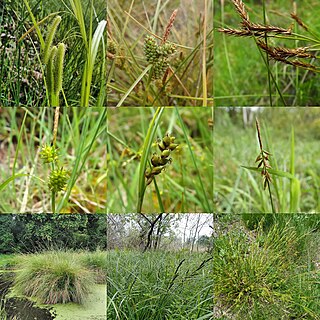
Carex is a vast genus of nearly 2,000 species of grass-like plants in the family Cyperaceae, commonly known as sedges. Other members of the family Cyperaceae are also called sedges, however those of genus Carex may be called true sedges, and it is the most species-rich genus in the family. The study of Carex is known as caricology.
NVC community M1 is one of the mire communities in the British National Vegetation Classification system.
NVC community M2 is one of the mire communities in the British National Vegetation Classification system.
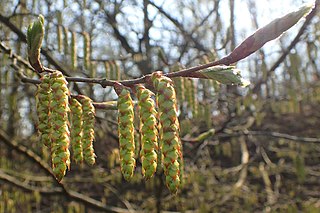
The Flora of Lithuania is estimated to comprise about 10,600 species. About 1,350 of these are vascular plants; about 335 are bryophytes; and about 2,000 are algae. Lichens are represented by about 500 species, and fungi by about 6,400 species. About 550 of these species are considered extinct or threatened. Protected areas now cover more than 12% of the territory of Lithuania.

The Wilderness is a Site of Special Scientific Interest which is located on the Isle of Wight, England. It is close to the village of Rookley in the valley of the River Medina. The Wilderness is an area of wet woodland over a quite deep peat soil with adjacent areas of unimproved acid grassland and wet grassland. The SSSI covers an area of 12.59 hectares, the boundaries being reset in 1984 to exclude an area of grassland which had been artificially improved.
Pike Whin Bog is a Site of Special Scientific Interest in the Easington district of east County Durham, England. It is situated just east of Hurworth Burn Reservoir, about 8 km west of Hartlepool.

Ireland is in the Atlantic European Province of the Circumboreal Region, a floristic region within the Holarctic.

Abbotts Moss is a 12-hectare (30-acre) nature reserve near Delamere Forest, northwest of Winsford, Cheshire. It is managed by the Cheshire Wildlife Trust under lease from the Forestry Commission and lies within a larger Site of Special Scientific Interest (SSSI). The reserve is south of the A556 road near Sandiway and is divided in two by the Whitegate Way, a former railway line now used as a footpath and bridleway.
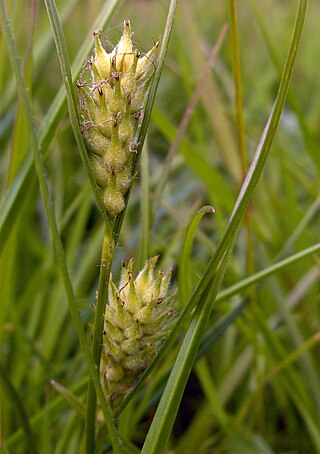
Carex hirta, the hairy sedge or hammer sedge, is a species of sedge native across Europe. It has characteristic hairy leaves and inflorescences, and is the type species of the genus Carex.

Eriophorum viridicarinatum is a species of sedge known by the common names thinleaf cottonsedge, green-keeled cottongrass, and bog cottongrass. It is native to northern North America, where it occurs in Alaska and throughout much of Canada, its range extending into the northern contiguous United States. Its distribution is more patchy in the west but it is widespread in eastern Canada.

Vaccinium oxycoccos is a species of flowering plant in the heath family. It is known as small cranberry, marshberry, bog cranberry, swamp cranberry, or, particularly in Britain, just cranberry. It is widespread throughout the cool temperate northern hemisphere, including northern Europe, northern Asia and northern North America.

Eriophorum scheuchzeri is a species of flowering plant in the sedge family known by the common names Scheuchzer's cottongrass and white cottongrass. It has an arctic circumpolar and circumboreal distribution in the Northern Hemisphere. It can be found in Alaska, across Canada, in the Arctic islands, Greenland, Iceland, and across Eurasia. Disjunct occurrences exist in the Rocky Mountains, in the high mountains of southern Europe and on Mount Daisetsu in Japan and some other Asian mountains.

The Alfred Bog is a domed peat bog in Eastern Ontario, Canada, about 7 kilometres (4.3 mi) south of Alfred and 70 kilometres (43 mi) east of Ottawa. The bog is considered the largest high-quality bog in Southern Ontario, and was designated by the Ontario Ministry of Natural Resources as a "Class 1 Wetland" and an "Area of Natural and Scientific Interest (ANSI)" in 1984. It is home to rare animal species and a healthy moose population.
Barelees Pond is the name given to a Site of Special Scientific Interest (SSSI) in north Northumberland, England. The site is a kettle hole, a deep pond formed in the void remaining after a submerged glacial calf block melted. Barelees Pond is illustrative of vegetative habitat evolution as peat sediment gradually fills the pond.
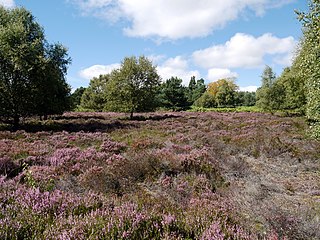
Bewick and Beanley Moors is the name given to a Site of Special Scientific Interest (SSSI) in north Northumberland, in the north-east of England. The moors are asserted to be of national importance by Natural England for the extent, quality and diversity of upland types including heaths, fens, wet grassland, flushes, mires and blanket bogs, together creating an extensive mosaic habitat supporting an exceptional community of amphibians. The moors are important, too, for their relict juniper woodland and scrub.

Trichophorum cespitosum, commonly known as deergrass or tufted bulrush, is a species of flowering plant in the sedge family. It was originally described by the Swedish naturalist Carl Linnaeus in 1753 as Scirpus cespitosus, but was transferred to the genus Trichophorum by the Swedish botanist Carl Johan Hartman in 1849, becoming Trichophorum cespitosum.
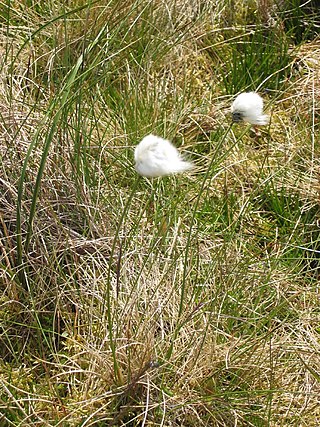
Eriophorum brachyantherum, the closed-sheath cotton-grass, short-anthered cotton-grass or northland cottonsedge, is a species that is a part of the Cyperaceae or sedge family. It is commonly found in wet areas, such as bogs and cooler climate zones.






















